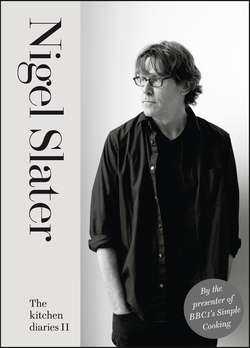Читать книгу The Kitchen Diaries II - Nigel Slater - Страница 13
JANUARY 1 A humble loaf and a soup of roots
ОглавлениеThe mistletoe – magical, pagan, sacred to Norsemen and the Druids – is still hanging over the low doorway to the kitchen. Part of the bough I dragged back from the market the Sunday before Christmas, my hands numb from the cold. Its leaves are dull now, the last few golden-white berries scattered over the stone floor. Like the holly in the hearth, its presence was a peace offering to the new kitchen that still awaits its work surface, cupboards, sink, taps.
There is an English mistletoe fair at the market in Tenbury Wells each Saturday throughout December. Vast, cloud-like bunches are cut from local cider-apple orchards and sold along with holly and skeins of ivy. Mine came from an oak tree in Hereford, though nowadays much of the folklore-laden evergreen arrives by less-than-romantic truck from northern France. It is only the mistletoe grown on oak that is imbued with magical powers.
Empty glasses are scattered around the room, perched on shelves and window ledges from where we toasted the new, albeit unfinished kitchen. And there is just enough Champagne left in a bottle in the fridge for me to celebrate, in secret, the first morning of the New Year.
This January 1st is no different from all the others, in that I will make soup and a loaf in what is now an annual ritual. Kneading is a good way to start the year. Tactile, peaceful, creative, there is something grounding about baking a loaf on New Year’s Day. We have baked bread since the New Stone Age.
There has been a decade of New Year’s loaves in this house: a simple white bun, its surface softened with a bloom of flour; a dimpled foccacia that left our fingers damp with olive oil; a less than successful baguette, as thin as a wand; a brown, seeded loaf we ate for days like fruit cake; a flatbread; a crispbread; and once a craggy cottage loaf, its top slid to one side like a drunk in a top hat. I forget the others.
This year’s bread is the simplest of them all, a single, hand-worked loaf of strong white flour and spelt – the ancient cousin of wheat that is currently enjoying a renaissance. (This is less considered than it sounds: they are simply the flours I happen to have left in the cupboard after making mince pies.) Modern spelt is a hybrid of the emmer wheat and goat grass grown since the Iron Age, and has found favour with those who consider modern, commercial wheat heavy on the gut. I like it for the faintly nutty quality it brings to the party.
Making a loaf is cooking at its most basic – a bag of flour and a pinch of salt, some warm water and something to make it rise (baking powder, yeast, a home-made leaven). Yet there is more to it than that. There is something therapeutic about kneading live, warm dough. We do it in order to make the dough softer and more elastic, but the feel of dough in the hand makes you consider yourself a craftsman of some sort, which of course you are. I often knead my bread dough every twenty minutes or so, rather than the customary twice. Each kneading only lasts for about a minute. I do it gently too, without bumping or slapping. I am not sure any good can come from treating our food like a punch-bag.
I will attempt to achieve the yeasty sourness I want by using a glass of cider in place of some of the usual water and will get the crust crisp by punching the oven up to almost its highest setting. I want a crackling crust that shatters over the table when you break it, and a soft wholemeal crumb within. A good plain loaf that smells slightly sour and faintly lactic, yeasty, with a subtle fruitiness to it – a quiet and humble loaf with which to start a new year.
